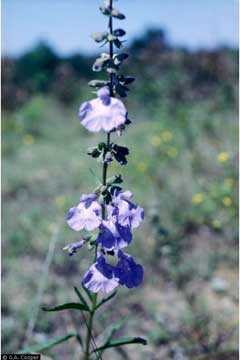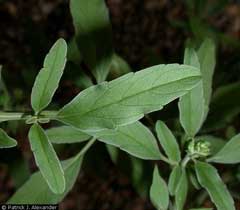 |
|
G.A. Cooper @ USDA-NRCS PLANTS Database |
 |
| Patrick J. Alexander @ USDA-NRCS PLANTS Database |
Translate this page:
Summary
Physical Characteristics

 Salvia reflexa is a ANNUAL growing to 0.8 m (2ft 7in). The species is hermaphrodite (has both male and female organs) and is pollinated by Insects.
Salvia reflexa is a ANNUAL growing to 0.8 m (2ft 7in). The species is hermaphrodite (has both male and female organs) and is pollinated by Insects.
Suitable for: light (sandy) and medium (loamy) soils and prefers well-drained soil. Suitable pH: mildly acid, neutral and basic (mildly alkaline) soils. It cannot grow in the shade. It prefers dry or moist soil.
UK Hardiness Map
US Hardiness Map
Synonyms
Plant Habitats
Cultivated Beds;
Edible Uses
Edible Parts: Seed
Edible Uses: Drink
The seeds are used in the preparation of a cooling drink[177, 183]. The following notes apply to S. hispanica, they are probably also appropriate for this species[K]. When soaked in water the seeds form a gelatinous mass which is flavoured with fruit juices and consumed as a cooling drink[183, 200]. The gelled seeds can also be prepared as a gruel or pudding[183]. The sprouted seeds are eaten in salads, sandwiches, soups, stews etc[183]. Due to their mucilaginous property they are often sprouted on clay or other porous materials[183]. The seed can be ground into a meal and made into bread, biscuits, cakes etc[183].
References More on Edible Uses
Medicinal Uses
Plants For A Future can not take any responsibility for any adverse effects from the use of plants. Always seek advice from a professional before using a plant medicinally.
None known
References More on Medicinal Uses
The Bookshop: Edible Plant Books
Our Latest books on Perennial Plants For Food Forests and Permaculture Gardens in paperback or digital formats.

Edible Tropical Plants
Food Forest Plants for Hotter Conditions: 250+ Plants For Tropical Food Forests & Permaculture Gardens.
More

Edible Temperate Plants
Plants for Your Food Forest: 500 Plants for Temperate Food Forests & Permaculture Gardens.
More

More Books
PFAF have eight books available in paperback and digital formats. Browse the shop for more information.
Shop Now
Other Uses
References More on Other Uses
Cultivation details
Requires a very well-drained light sandy soil in a sunny position[200]. Prefers a rich soil[1]. Plants can be killed by excessive winter wet[200]. Members of this genus are rarely if ever troubled by browsing deer[233].
References Carbon Farming Information and Carbon Sequestration Information
Temperature Converter
Type a value in the Celsius field to convert the value to Fahrenheit:
Fahrenheit:
The PFAF Bookshop
Plants For A Future have a number of books available in paperback and digital form. Book titles include Edible Plants, Edible Perennials, Edible Trees,Edible Shrubs, Woodland Gardening, and Temperate Food Forest Plants. Our new book is Food Forest Plants For Hotter Conditions (Tropical and Sub-Tropical).
Shop Now
Plant Propagation
Seed - sow March/April in a greenhouse. The seedlings dislike root disturbance, so prick them out carefully into individual pots as soon as they are large enough to handle. Plant them out in late spring or early summer. The seed can also be sown in situ during April/May, though this sowing might not mature its seed in a cool summer[200].
Other Names
If available other names are mentioned here
Native Range
NORTHERN AMERICA: United States (Indiana, Ohio (west), Illinois, Iowa, Kansas, Minnesota (s. & w.), Missouri, Nebraska, North Dakota, Oklahoma, South Dakota, Wisconsin, Colorado, Montana, Wyoming, Arkansas, New Mexico, Texas, Arizona, Utah (east)), Mexico (Chihuahua, Coahuila de Zaragoza, Durango, Nuevo León, Sinaloa, Sonora, Tamaulipas, Zacatecas, Aguascalientes, Ciudad de México, Guanajuato, Hidalgo, Jalisco, México, Michoacán de Ocampo, Oaxaca, Puebla, Querétaro, Veracruz de Ignacio de la Llave)
Weed Potential
Right plant wrong place. We are currently updating this section.
Please note that a plant may be invasive in one area but may not in your area so it's worth checking.
Conservation Status
IUCN Red List of Threatened Plants Status :

| Related Plants
|
| Latin Name | Common Name | Habit | Height | Hardiness | Growth | Soil | Shade | Moisture | Edible | Medicinal | Other |
| Cistus salviifolius | Rock Rose, Salvia cistus, Sage Leaf Rock Rose | Shrub | 0.6 |
8-11
| F | LM | N | DM | 1 | 0 | 3 |
| Salvia apiana | White Sage, Compact white sage | Perennial | 3.0 |
7-10
| M | LM | N | DM | 3 | 1 | 3 |
| Salvia ballotaeflora | | Annual | 0.0 |
-
| | LM | N | DM | 1 | 0 | |
| Salvia carduacea | Thistle Sage | Annual/Perennial | 0.7 |
7-10
| | LM | N | DM | 2 | 0 | |
| Salvia carnosa | Purple Sage | Shrub | 0.8 |
6-9
| | LM | N | DM | 1 | 2 | |
| Salvia clevelandii | Blue Sage, Fragrant sage, Chaparral Sage | Shrub | 0.6 |
8-11
| M | LM | N | DM | 1 | 0 | 2 |
| Salvia columbariae | Chia, Ziegler's sage | Annual/Perennial | 0.7 |
6-9
| | LM | N | DM | 3 | 2 | |
| Salvia dorisiana | Sage Fruity Pineapple | Perennial | 1.3 |
9-12
| F | LMH | SN | M | 3 | 0 | 3 |
| Salvia dorrii | Purple Sage | Shrub | 0.6 |
5-9
| F | LM | N | DM | 3 | 2 | 3 |
| Salvia elegans | Pineapple Sage, Pineapple-scented Sage, | Perennial | 1.0 |
8-11
| M | LM | N | DM | 3 | 1 | 3 |
| Salvia fruticosa | Greek Sage, Greek oregano | Shrub | 1.0 |
8-11
| M | LM | N | DM | 2 | 3 | 3 |
| Salvia glabrescens | | Perennial | 0.3 |
-
| | LM | SN | DM | 1 | 0 | |
| Salvia glutinosa | Jupiter's Distaff, Sticky Sage | Perennial | 1.2 |
4-8
| | LM | SN | DM | 1 | 0 | 3 |
| Salvia hispanica | Mexican Chia, Chia | Annual | 1.0 |
8-11
| M | LM | N | DM | 3 | 0 | 2 |
| Salvia japonica | | Perennial | 0.8 |
7-10
| | LM | SN | DM | 1 | 0 | 2 |
| Salvia lanata | | Perennial | 0.3 |
6-9
| | LM | N | DM | 1 | 1 | |
| Salvia lanigera | Wrinkle-Leaved Sage | Shrub | 0.0 |
-
| | LM | N | DM | 1 | 0 | |
| Salvia lavandulifolia | Spanish Sage | Shrub | 0.3 |
4-8
| | LM | N | DM | 2 | 3 | 2 |
| Salvia leucantha | Mexican Bush Sage | Shrub | 1.2 |
8-10
| F | LMH | N | M | 0 | 1 | 3 |
| Salvia lyrata | Cancer Weed, Lyreleaf Sage | Perennial | 0.6 |
4-9
| M | LM | N | DM | 0 | 2 | 0 |
| Salvia mellifera | Californian Black Sage | Shrub | 2.0 |
7-10
| | LM | N | DM | 1 | 2 | |
| Salvia microphylla | Blackcurrant Sage | Perennial | 1.2 |
7-10
| | LM | N | DM | 2 | 2 | |
| Salvia moorcroftiana | | Perennial | 0.9 |
6-9
| | LM | N | DM | 1 | 1 | |
| Salvia multicaulis | | Shrub | 0.3 |
7-10
| | LM | N | DM | 1 | 0 | |
| Salvia multiorrhiza | Dan Shen | Perennial | 0.6 |
5-9
| | LM | N | DM | 0 | 3 | |
| Salvia officinalis | Sage, Kitchen sage, Small Leaf Sage, Garden Sage | Shrub | 0.6 |
5-10
| M | LM | N | DM | 4 | 5 | 5 |
| Salvia plebeia | | Biennial | 0.5 |
-
| | LM | N | MWe | 1 | 1 | |
| Salvia pomifera | Apple Sage | Shrub | 1.0 |
7-10
| M | LM | N | DM | 2 | 2 | 2 |
| Salvia pratensis | Meadow Clary, Introduced sage | Perennial | 1.0 |
3-7
| | LM | N | DM | 1 | 0 | 0 |
|
|
Growth: S = slow M = medium F = fast. Soil: L = light (sandy) M = medium H = heavy (clay). pH: A = acid N = neutral B = basic (alkaline). Shade: F = full shade S = semi-shade N = no shade. Moisture: D = dry M = Moist We = wet Wa = water.
Now available:
Food Forest Plants for Mediterranean Conditions
350+ Perennial Plants For Mediterranean and Drier Food Forests and Permaculture Gardens.
[Paperback and eBook]
This is the third in Plants For A Future's series of plant guides for food forests tailored to
specific climate zones. Following volumes on temperate and tropical ecosystems, this book focuses
on species suited to Mediterranean conditions—regions with hot, dry summers and cool, wet winters,
often facing the added challenge of climate change.
Read More
Expert comment
Author
Hornem.
Botanical References
43200274
Links / References
For a list of references used on this page please go here
Readers comment
| Add a comment |
|
If you have important information about this plant that may help other users please add a comment or link below. Only comments or links that are felt to be directly relevant to a plant will be included. If you think a comment/link or information contained on this page is inaccurate or misleading we would welcome your feedback at [email protected]. If you have questions about a plant please use the Forum on this website as we do not have the resources to answer questions ourselves.
* Please note: the comments by website users are not necessarily those held by PFAF and may give misleading or inaccurate information.
To leave a comment please Register or login here All comments need to be approved so will not appear immediately.
|
|